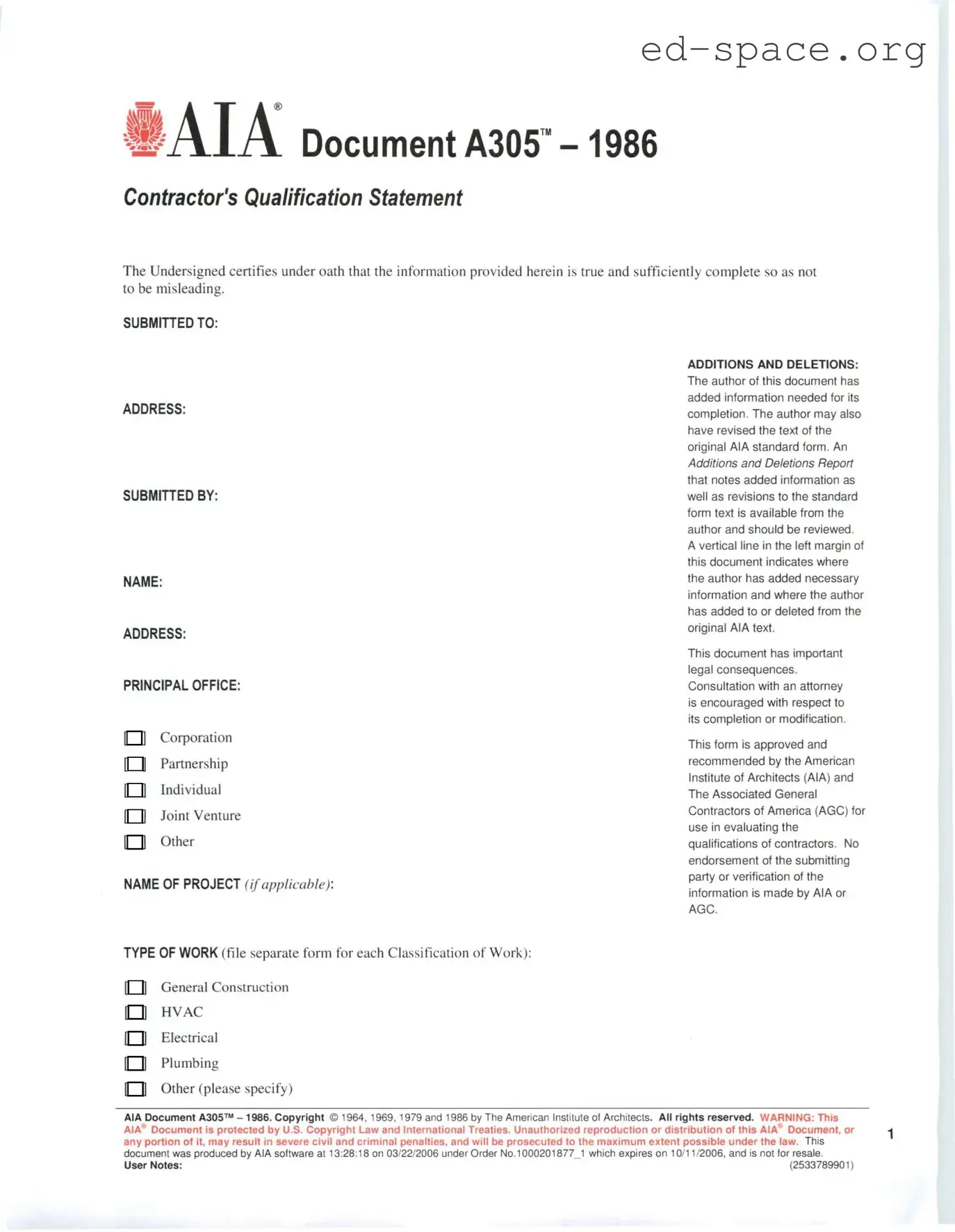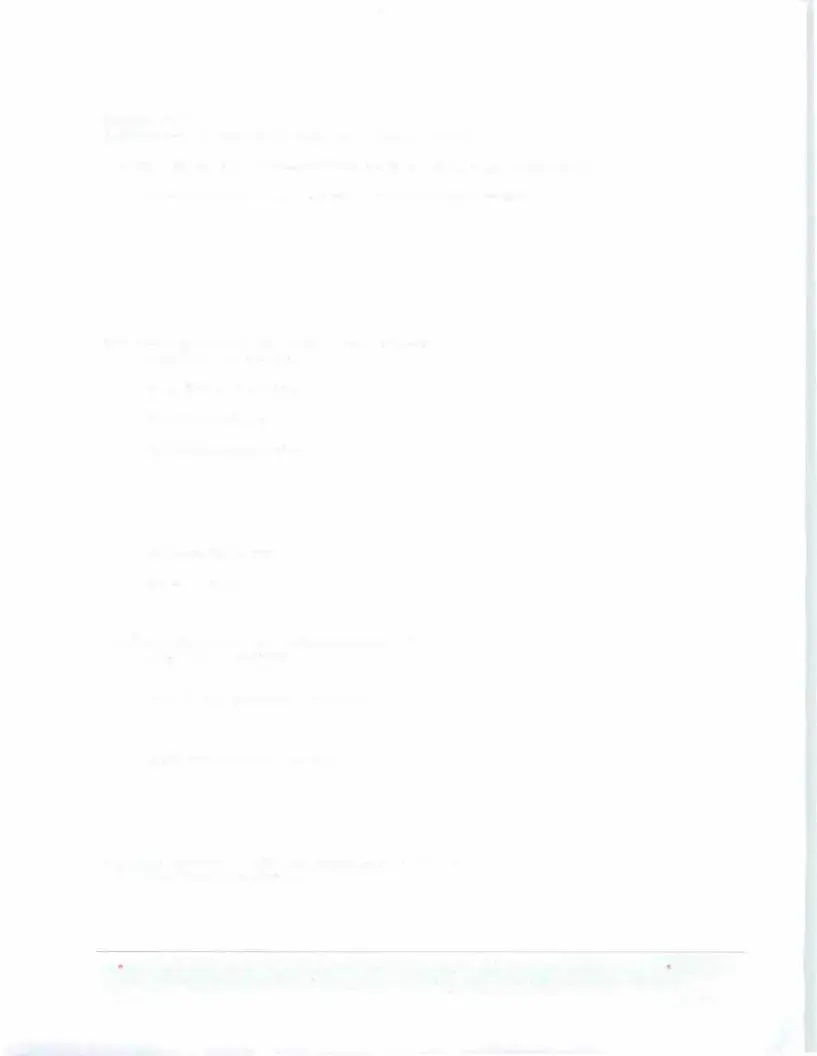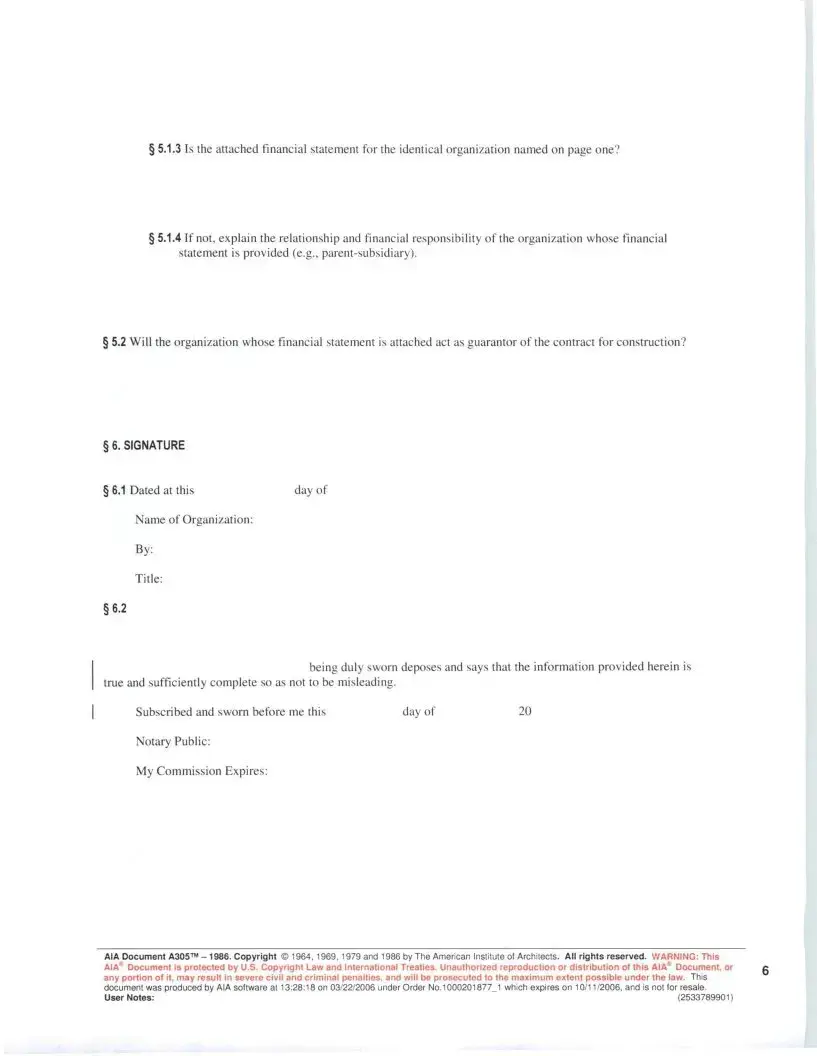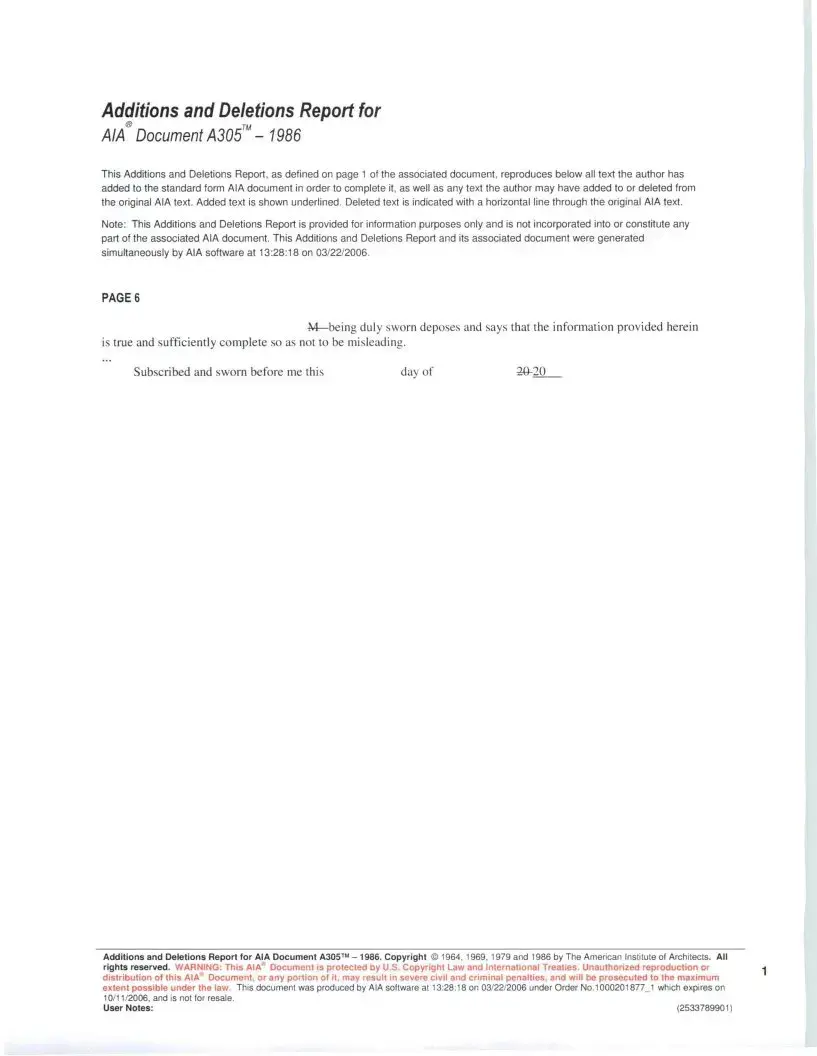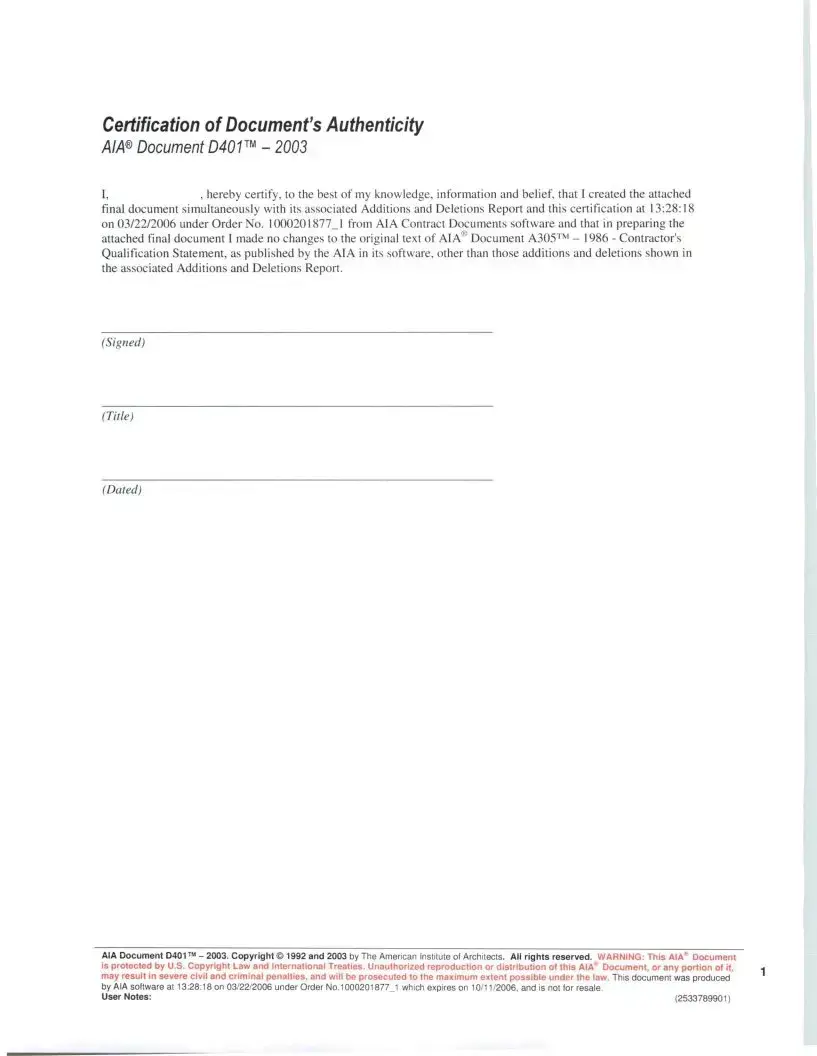 AlA Document A305" - 1986
AlA Document A305" - 1986
Contractor's Qualification Statement
The Undersigned certifies under oath that the information provided herei n is true and sufficiently complete so as not to be misleading.
SUBMITTED TO:
ADDRESS:
SUBMITTED BY:
NAME:
ADDRESS:
PRINCIPAL OFFICE:
ADDITIONS AND DELETIONS:
The author of this document has added information needed for its completion. The author may also have revised the text of the original AlA standard form. An Additions and Deletions Report that notes added information as well as revisions to the standard form text is available from the author and should be reviewed . A vertical line in the left margin of this document indicates where the author has added necessary information and where the author has added to or deleted from the original AlA text.
This document has important legal consequences. Consultation with an attorney is encouraged with respect to its completion or modification.
|
Corporation |
|
This form is approved and |
|
|
|
|
Partnership |
|
recommended by the American |
|
Individua l |
|
Institute of Architects (AlA) and |
|
|
The Associated General |
|
|
|
|
Joint Venture |
|
Contractors of America (AGC) for |
|
|
use in evaluating the |
|
|
|
|
Other |
|
qualifications of contractors . No |
|
|
|
endorsement of the submitting |
|
NAME OF PROJECT |
(if applicable): |
party or verification of the |
|
information is made by AlA or |
|
|
|
|
|
|
AGC. |
TYPE OF WORK (file separate form for each Classification of Work ):
General Construction
HVAC
Electrical
Plumbing
Other (please specify)
AlA Document A305™ -1 986. Copyright © 1964,1969,1979 and 1986 by The American Institute of Architects. All rights reserved. WARNING: This |
1 |
AfA Document is protected by U.S. Copyright Law and International Treaties. Unauthorized reproduction or distribution of this AlA |
Document, or |
any portion of it, may result in severe civil and criminal penalties, and will be prosecuted to the maximum extent possible under the law. This |
|
document was produced by AlA software at 13:28:18 on 03/22/2006 under Order No.1000201877_ 1 which expires on 10/11 /2006 , and is not for resale. |
|
User Notes: |
(2533789901) |
|
§1. ORGANIZATION
§1.1 How many years has your organization been in business as a Contractor?
§1.2 How many years has your organization been in business under its present business name?
§1.2.1 Under what other or former names has your organization operated?
§1.3 If your organization is a corporation, answer the following:
§1.3.1 Date of incorporation:
§1.3.2 State of incorporation:
§1.3.3 President's name:
§1.3.4 Vice-president's name(s)
§1.3.5 Secretary's name:
§1.3.6 Treasurer's name:
§1.4 If your organization is a partnership, answer the following:
§1.4.1 Date of organization:
§1.4.2 Type of partnership (if applicable):
§1.4.3 Name(s) of general pa11ner(s)
§1.5 If your organization is individually owned, answer the following:
§1.5.1 Date of organization:
AIA Document A305™ -1986. Copyright© 1964, 1969, 1979 and 1986 by The American Institute of Architects. All rights reserved. WARNING: This |
2 |
AIA Document is protected by U.S. Copyright Law and International Treaties. Unauthorized reproduction or distribution of this AIA |
Document, or |
any portion of It, may result in severe civil and criminal penalties, and will be prosecuted to the maximum extent possible under the law. This |
|
document was produced by AIA soltware at 13:28:18 on 03/22/2006 under Order No.1000201877_1 which expires on 10/11/2006, and is not for resale. |
|
User Notes: |
(2533789901) |
|
§1.5.2 Name of owner:
§1.6 If the form of your organization is other than those listed above, describe it and name the principals:
§2. LICENSING
§2.1 List jurisdictions and trade categories in which your organization is legally qualified to do business, and indicate registration or license numbers, if applicable .
§2.2 List jurisdictions in whic h your organization 's partnership or trade name is filed.
§3. EXPERIENCE
§3.1 List the categories of work that your organization normally performs with its own forces.
§3.2 Claims and Suits. (If the answer to any of the questions below is yes, please attach details.)
§3.2.1 Has your organization ever fai led to complete any work awarded to it?
§3.2.2 Are there any judgments, claims, arbitration proceedings or suits pending or outstandi ng agai nst you r organization or its officers?
AlA Document A305™ -1 986. Copyright © 1964, 1969, 1979 and 1986 by The American Institute of Architects. All rights reserved. WARNING: This |
3 |
AlA Document is protected by U.S. Copyright Law and International Treaties. Unauthorized reproduction or distribution of this AlA |
Document, or |
any portion of it, may result in severe civil and criminal penalties, and will be prosecuted to the maximum extent possible under the law. This |
|
document was produced by AlA software at 13:28:18 on 03/22/2006 under Order No.1 000201877_ 1 which expires on 10/ 11 /2006 , and is not for resale . |
|
User Notes: |
(2533789901 ) |
|
§3.2.3 Has your organization filed any law suits or requested arbitration with regard to construction contracts within the last five years?
§3.3 Within the last five years, has any officer or principal of your organization ever been an officer or principal of another organization when it failed to complete a construction contract? (If the answer is yes, please attach details.)
§3.4 On a separate sheet, list major construction projects your organization has in progress, giving the name of project, owner, architect, contract amount, percent complete and scheduled completion date.
§3.4.1 State total worth of work in progress and under contract:
§3.5 On a separate sheet, list the major projects your organization has completed in the past five years, giving the name of project, owner, architect, contract amount, date of completion and percentage of the cost of the work performed with your own forces.
§3.5.1 State average annual amount of construction work performed during the past five years:
§3.6 On a separate sheet, list the construction experience and present commitments of the key individuals of your organization.
AIA Document A305™ -1986. Copyright© 1964, 1969, 1979 and 1986 by The American Institute of Architects. All rights reserved. WARNING: This
AtA Document is protected by U.S. Copyright Law and International Treaties. Unauthorized reproduction or distribution of this AIA |
Document, or |
4 |
any portion of it, may result in severe civil and criminal penalties, and will be prosecuted to the maximum extent possible under the law. This |
document was produced by AIA software at 13:28:18 on 03/22/2006 under Order No.1000201877_1 which expires on 10/11/2006, and is not for resale. |
|
User Notes: |
(2533789901) |
|
§4. REFERENCES
§4.1 Trade References:
§4.2 Bank References:
§4.3 Surety:
§4.3.1 ame of bonding company:
§4.3.2 Name and address of agent:
§5. FINANCING
§5.1 Financial Statement.
§5.1.1 Attach a financial statement, preferably audited, including your organization's latest balance sheet and income statement showing the following items:
Current Assets (e.g., cash, joint venture accounts, accounts receivable, notes receivable, accrued income, deposits, materia ls inventory and prepaid expenses);
et Fixed Assets;
Other Assets;
Current Liabi li ties (e.g., accounts payable, notes payable, accrued expenses, provision for income taxes, adva nces, accrued salaries and accrued payroll taxes);
Other Liabilities (e.g ., capital , capital stock, authorized and outstandi ng shares par values, earned surplus and retai ned earnings).
§ 5.1.2 Name and add ress of firm preparing attached financial statement, and date thereof:
AlA Document A305™ - 1986. Copyright © 1964, 1969, 1979 and 1986 by The American Institute of Architects. All rights reserved. WARNING : This |
5 |
AlA Document is protected by U.S. Copyright Law and International Treaties. Unauthorized reproduction or distribution of this AlA |
Document, or |
any portion of it, may result in severe civil and criminal penalties, and will be prosecuted to the maximum extent possible under the law. This |
|
document was produced by AlA software at 13:28:18 on 03/22/2006 under Order NO.1000201877_ 1 which expires on 10/ 11 /2006. and is not for resale. |
|
User Notes: |
(2533789901 ) |
|
§5.1.3 Is the attached financial statement for the identical organization named on page one?
§5.1.4 If not, explain the relationship and financial responsibility of the organization whose financial statement is provided (e.g. , parent-subsidiary) .
§5.2 Will the organization whose financial statement is attached act as guarantor of the contract for construction ?
§6. SIGNATURE
§ 6.1 Dated at this |
day of |
ame of Organization:
By:
Title:
§6.2
being du ly sworn deposes and says that the information provided herein is true and sufficiently complete so as not to be mis leading .
Subscribed and sworn before me this |
day of |
20 |
Notary Public:
My Commission Expires:
AlA Document A305™ - 1986. Copyright © 1964, 1969, 1979 and 1986 by The American Institute of Architecls. All rights reserved. WARNING: This |
6 |
AlA Document is protected by U.S. Copyright Law and International Treaties. Unauthorized reproduction or distribution of this AlA |
Document, or |
any portion of it, may result in severe civil and criminal penalties, and will be prosecuted to the maximum extent possible under the law. This |
|
document was produced by AlA software at t 3:28:18 on 03/22/2006 under Order NO .1000201877_ 1 which expires on 10/ 11 /2006 , and is not for resale . |
|
User Notes: |
(2533789901 ) |
|
Additions and Deletions Report for
AlA® Document A305TM - 1986
This Additions and Deletions Report , as defined on page 1 of the associated document, reproduces below all text the author has added to the standard form AlA document in order to complete it, as well as any text the author may have added to or deleted from the original AlA text. Added text is shown underlined. Deleted text is indicated with a horizontal line through the original AlA text.
Note: This Additions and Deletions Report is provided for information purposes only and is not incorporated into or constitute any part of the associated AlA document. This Additions and Deletions Report and its associated document were generated simultaneously by AlA software at 13:28:18 on 03/22/2006.
PAGE 6
M-being duly sworn deposes and says that the information provided herein is true and sufficiently complete so as not to be misleading.
Subscribed and sworn before me this |
day of |
Additions and Deletions Report for AlA Document A305™ -1986. Copyright © 1964, 1969, 1979 and 1986 by The American Instilute of Architects. |
All |
rights reserved. WARNING: This AlA Document is protected by U.S. Copyright Law and International Treaties. Unauthorized reproduction or |
1 |
distribution of this AlA ' Document, or any portion of it, may result in severe civil and criminal penalties, and will be prosecuted to the maximum extent possible under the law. This document was produced by AlA software at 13:28:18 on 03/22/2006 under Order No .1 000201877_ 1 which expires on
10/11 /2006 , and is not for resale . |
|
User Notes: |
(2533789901) |
Certification of Document's Authenticity
AIA® Document D401™ - 2003
I, Charles V. Bucci , hereby certify, to the best of my knowledge, information and belief, that I created the attached final document simultaneously with its associated Additions and Deletions Report and this certification at 13:28: 18 on 03/22/2006 under Order No. 1000201877_1 from AIA Contract Documents software and that in preparing the attached fina l document I made no changes to the original text of AIA® Document A305™ - 1986 - Contractor's Qualification Statement, as published by the AIA in its software, other than those additions and deletions shown in the associated Additions and Deletions Report.
(Signed)
(Title)
(Dated)
AlA Document D40FM - 2003. Copyright © 1992 and 2003 by The American Institute of Architects. All rights reserved. |
WARNING: This AlA- Document |
1 |
Is protected by U.S. Copyright Law and International Treaties . Unauthorized reproduction or distribution of this AlA |
Document, or any portion of it, |
may result in severe civil and criminal penalties, and will be prosecuted to the maximum extent possible under the law. This document was produced |
|
by AlA software at 13:28:18 on 03/22/2006 under Order No .1 000201877_ 1 which expires on 10/11 /2006 , and is not for resale. |
|
User Notes: |
(2533789901) |
|
